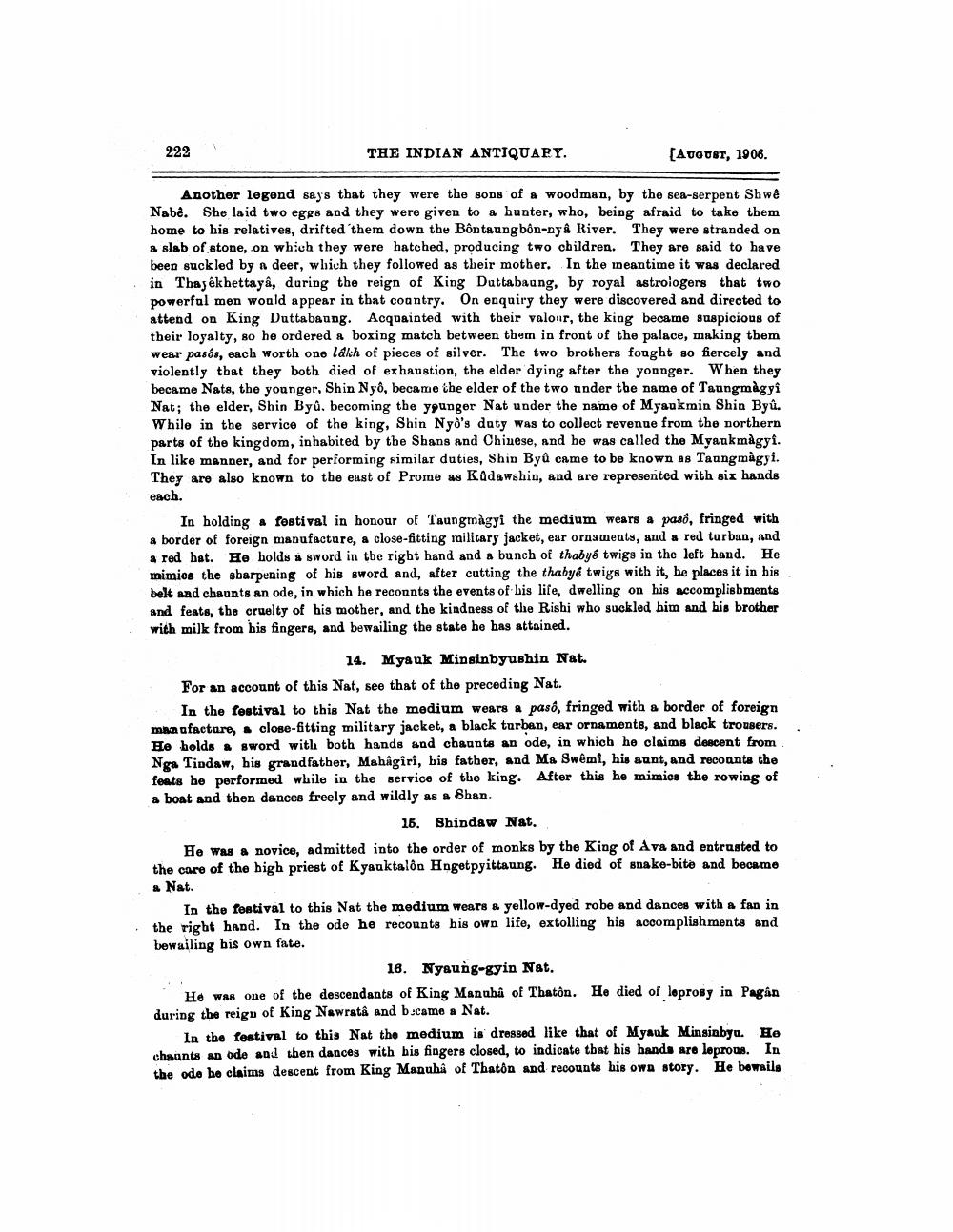________________
222
THE INDIAN ANTIQUAPY.
[August, 1906.
Another legend says that they were the sons of a woodman, by the sea-serpent Shwe Nabê. She laid two eggs and they were given to a hanter, who, being afraid to take them home to his relatives, drifted them down the Bôn taung bôn-nya River. They were stranded on a slab of stone, on which they were hatched, producing two children. They are said to have been suckled by deer, which they followed as their mother. In the meantime it was declared in Thasekhettaya, during the reign of King Dattabaung, by royal astrologers that two powerful men would appear in that country. On enquiry they were discovered and directed to attend on King Duttabaung. Acquainted with their valour, the king became suspicious of their loyalty, so he ordered a boxing match between them in front of the palace, making them wear pasos, each worth one lakh of pieces of silver. The two brothers fought so fiercely and violently that they both died of exhaustion, the elder dying after the younger. When they became Nats, the younger, Shin Nyô, became the elder of the two under the name of Taungmàggi Nat; the elder, Shin Byû, becoming the younger Nat under the name of Myaukmin Shin Byů. While in the service of the king, Shin Nyo's duty was to collect revenue from the northern parts of the kingdom, inhabited by the Shans and Chinese, and he was called the Myaukmàgyi. In like manner, and for performing similar duties, Shin Byû came to be known as Taungmàgyi. They are also known to the east of Prome as Kûdawshin, and are represented with six hands each.
In holding a festival in honour of Taungmagyi the medium wears a pasó, fringed with a border of foreign manufacture, a close-fitting military jacket, ear ornaments, and a red turban, and a red hat. He holds a sword in the right hand and a bunch of thaby& twigs in the left hand. He mimics the sharpening of his sword and, after cutting the thabyế twigs with it, he places it in bis belt and chaunts an ode, in which he recounts the events of bis life, dwelling on his accomplishments and feats, the cruelty of his mother, and the kindness of the Rishi who suckled him and his brother with milk from his fingers, and bewailing the state he has attained.
.
14. Myauk Minsinbyushin Nat. For an account of this Nat, see that of the preceding Nat.
In the festival to this Nat the medium wears a paso, fringed with a border of foreign manufacture, close-fitting military jacket, a black turban, ear ornaments, and black trousers. He holds & sword with both hands and cheants an ode, in which he claims descent from Nga Tindaw, his grandfather, Mahagiri, his father, and Ma Swêmi, his aunt, and recounts the feats he performed while in the service of the king. After this he mimics the rowing of a boat and then dances freely and wildly as a Shan.
15. Shindaw Nat. He was a novice, admitted into the order of monks by the King of Ava and entrusted to the care of the high priest of Kyauktalog Hngetpyittaung. He died of snake-bito and became & Nat.
In the festival to this Nat the medium wears a yellow-dyed robe and dances with a fan in the right hand. In the ode he recounts his own life, extolling his accomplishments and bewailing his own fate.
16. Nyaung-gyin Nat. He was one of the descendants of King Manuha of Thaton. He died of leprosy in Pagan during the reign of King Newratâ and became a Nat.
In the festival to this Nat the medium is dressed like that of Myauk Minsinbyu. He chaunts an ode and then dances with bis fingers closed, to indicate that his hands are loprous. In the ode ho claims descent from King Manuba of Thaton and recounts his own story. He bowails




